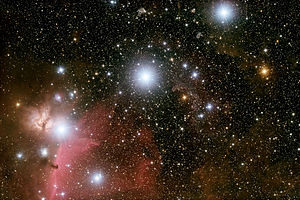Delta Orionis
| Observation data Epoch J2000 Equinox J2000 |
|
|---|---|
| Constellation | Orion |
| δ Ori A (Aa1 + Aa2 + Ab) | |
| Right ascension | 05h 32m 00.40009s |
| Declination | −00° 17′ 56.7424″ |
| Apparent magnitude (V) | 2.23(2.50 + 3.90) |
| δ Ori B | |
| Right ascension | 05h 31m 58.745s |
| Declination | −00° 18′ 18.65″ |
| Apparent magnitude (V) | 14.0 |
| HD 36485 | |
| Right ascension | 05h 32m 00.406s |
| Declination | −00° 17′ 04.38″ |
| Apparent magnitude (V) | 6.85 |
| Characteristics | |
| Spectral type | (O9.5II + B1V +B0IV) + B3V |
| U−B color index | −1.05 |
| B−V color index | −0.22 |
| Variable type | Eclipsing binary |
| Astrometry | |
| Radial velocity (Rv) | 18.50 ± 0.5 km/s |
| Proper motion (μ) |
RA: 0.64 ± 0.56 mas/yr Dec.: -0.69 ± 0.27 mas/yr |
| Parallax (π) | 4.71 ± 0.58mas |
| Distance | 1,200ly (380pc) |
| Absolute magnitude (MV) | −5.8 |
| δ Ori Aa1 | |
| Absolute magnitude (MV) | −5.4 |
| δ Ori Aa2 | |
| Absolute magnitude (MV) | −2.9 |
| δ Ori Ab | |
| Absolute magnitude (MV) | −4.2 |
| Details | |
| δ Ori Aa1 | |
| Mass | 24 M☉ |
| Radius | 16.5 R☉ |
| Luminosity | 190,000 L☉ |
| Surface gravity (log g) | 3.37 ± 0.15 cgs |
| Temperature | 29,500 ± 500 K |
| Rotational velocity (v sin i) | 130 ± 10 km/s |
| δ Ori Aa2 | |
| Mass | 8.4 M☉ |
| Radius | 6.5 R☉ |
| Luminosity | 16,000 L☉ |
| Surface gravity (log g) | 3.9 cgs |
| Temperature | 25,600 ± 3,000 K |
| Rotational velocity (v sin i) | 150 ± 50 km/s |
| δ Ori Ab | |
| Mass | 22.5 M☉ |
| Radius | 10.4 R☉ |
| Luminosity | 63,000 L☉ |
| Surface gravity (log g) | 3.5 ± 0.3 cgs |
| Temperature | 28,400 ± 1,500 K |
| Rotational velocity (v sin i) | 220 ± 20 km/s |
| HD 36485 | |
| Mass | ~9 M☉ |
| Radius | 5.7 R☉ |
| Luminosity | 3,300 L☉ |
| Surface gravity (log g) | 4.41 cgs |
| Temperature | 18,400 K |
| Orbit | |
| Primary | δ Ori Aa1 |
| Companion | δ Ori Aa2 |
| Period (P) | 5.732436 days |
| Semi-major axis (a) | 43.1 ± 1.7 R☉ |
| Eccentricity (e) | 0.1133 ± 0.0003 |
| Inclination (i) | 76.5 ± 0.2° |
| Periastron epoch (T) | 2456295.674 ± 0.062 |
|
Argument of periastron (ω) (secondary) |
141.3 ± 0.2° |
| Other designations | |
| Mintaka Aa: HD 36486, HR 1851, SAO 132220/132221, BD−00°983, GC 6847 | |
| Mintaka Ab: δ Orionis B, CCDM J05320-0018D, WDS J05320-0018Ab | |
| δ Ori B: UCAC3 180-24383, CCDM J05320-0018B, WDS J05320-0018B | |
| HD 36485: δ Orionis C, HR 1851, SAO 132221, BD−00°982, GC 6848, PLX 1261, CCDM J05320-0018C | |
| Database references | |
| SIMBAD | δ Ori A data |
| SIMBAD | δ Ori B data |
| SIMBAD | HD 36485 data |
Mintaka, also designated Delta Orionis (δ Orionis, abbreviated Delta Ori, δ Ori) and 34 Orionis (34 Ori) is a multiple star some 1,200 light years from the Sun in the constellation of Orion. Together with Alnitak (Zeta Orionis) and Alnilam (Epsilon Orionis), the three stars make up the belt of Orion, known by many names among ancient cultures. When Orion is close to the meridian, Mintaka is the right-most of the belt's stars as seen by an observer in the Northern Hemisphere facing south.
Delta Orionis is the star's Bayer designation, 34 Orionis its Flamsteed designation. The name Mintaka itself is derived from an Arabic term for 'belt': منطقة or manṭaqa. In 2016, the International Astronomical Union organized a Working Group on Star Names (WGSN) to catalog and standardize proper names for stars. The WGSN's first bulletin of July 2016 included a table of the first two batches of names approved by the WGSN; which included Mintaka for this star. It is now so entered in the IAU Catalog of Star Names.
Mintaka is the westernmost of the three stars of Orion's belt. It is easily visible to the naked eye, one of the brightest stars in the sky, and has been known since antiquity.
Radial velocity measurements taken by Henri-Alexandre Deslandres at Paris Observatory showed that Mintaka had a variable radial velocity and therefore was a spectroscopic binary. His preliminary orbital period estimate of 1.92 days was shown to be incorrect in 1904 when Johannes Franz Hartmann using photographic plates taken at Potsdam Observatory showed that the orbital period was 5.7 days. Hartmann also noticed that the calcium K line at 393.4 nanometres in the stellar spectrum did not share in the periodic displacements of the lines due to orbital motion of the star and theorized that there was a cloud in the line of sight to Mintaka that contained calcium. This was the first detection of the interstellar medium.
...
Wikipedia

